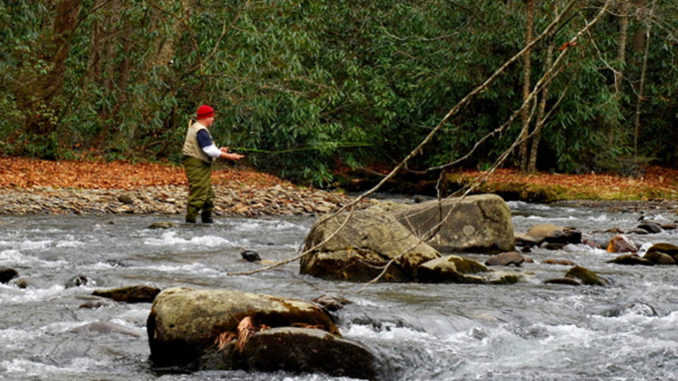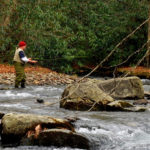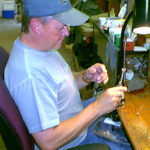
Full streams, active fish make for April joy
Spring is a magical time in the mountains, a time when dogwoods bud and the reddish-pink flowers of redbuds and white and pale pink flowers of serviceberry trees reach full bloom. Wildflowers break through the tangle of dead weeds, stems, decaying leaves and other debris as extended sunlight warms the earth. The delicate blues, stark whites, pinks and yellows of hepatica, windflower, trout lily, wood anemone, spring beauty, bloodroot and a variety of violets and trillium brighten trails, stream banks and forest edges.
Best of all, spring is a prime time for trout fishing.
Beginning around the middle of March and continuing through May, mountain streams start warming up, browns, rainbows, and brook trout become active and hungry, and mountain anglers enjoy some of the best trout fishing of the year.
Hatches occur frequently and in great variety and abundance. Trout become veritable eating machines. Mountain streams are full and clear this spring due to the frequent and sometimes heavy winter rains. More water means more oxygen in the water, which also makes fish more active. Even a trout fisher with marginal skills has a greater chance of catching fish in the spring than any other time.
Four veteran fly fishers and guides shared tips that will ensure productive spring outings: Roger Lowe, a third-generation fly fisher and now guide for Brookings’ Anglers in Cashiers; Kevin Howell, a third-generation fly fisher and owner of Davidson Rivers Outfitters in Brevard; Shane Buckner, fishing guide and manager of Hunter Banks Company in Asheville, and guide Forrest Marshall, also of Hunter Banks.
Fly sizes can range from a tiny No. 26 for midge patterns to a large No. 2 for streamers such as a Woolly Booger. A standard size for spring fishing with nymphs or dry flies is Nos. 18 to 14.
Dry-fly patterns covering the broadest range of spring hatches include: Black Caddis, March Brown, Blue-Winged Olive, Sheep Fly, Hendrickson, and Quill Gordon. Attractor patterns are recommended when no obvious hatch is present, and they include parachute and regular Adams, olive Stimulator and yellow Palmer. Good spring nymph patterns include Hare’s Ear (standard or bead-head), Prince, Pheasant Tail (flashback or regular), Stick Bait, Tellico, rubber-legged Girdlebug and Woolly Booger in all colors. The Woolly Booger can be especially effective during high-water conditions. In delayed-harvest waters, egg patterns and worm patterns such as the San Juan Worm and Squirmy-Wormy are good fallback baits.
Use droppers for both top and subsurface action. Tie a section of tippet on the shank or hook of a dry fly and use a small nymph as a trailer, usually two sizes smaller than the top fly. The tippet can be one to three feet long, depending on the size of the stream and depth of the water. If you fail to get a strike with a nymph, add extra weight to get the fly down to the fish.
To determine whether to fish with a nymph or dry fly, Lowe says to observe how fish are feeding: “If their heads show, use a dry fly; if their tails show, they are feeding below the surface.”
Time of day is an important factor in a productive spring outing. Avoid cold mornings and fish late in the morning, afternoons and early evening. Overcast days are ideal for fishing — you can’t cast your shadow on the water.
Check your fishing gear. Replace worn line and leaders, update your flies and make sure your equipment is in good condition. Rod guides can develop grooves after repeated casting. Howell suggests running a small section of panty-hose or similar material through rod guides. If the material catches, the guides need replacing.
Leader length and size depend on water conditions. In smaller mountain streams, a 7 ½-foot leader with a 4X to 7X tippet is recommended. For larger streams, use a 9 ½-foot leader. Buckner recommends using fluorocarbon leader and tippet: “It’s less visible to fish, it sinks naturally and it’s more sensitive” than standard tippet.
Some excellent streams for spring fishing are: Davidson River, West Fork Pigeon River (wild-trout section), East Fork French Broad River, South Mills River above the gauge station, and Oconaluftee River, Bradley Fork, Deep Creek and Cataloochee Creek in the Great Smoky Mountains National Park. All three guides highly recommend delayed-harvest streams for fool-proof fishing, particularly the Tuckasegee River in Jackson County, the upper Nantahala River in Macon County and the Watauga River in Watauga County. Delayed-harvest streams received bonus stockings in March, so trout will be plentiful, and so will the trout fishers.






Be the first to comment